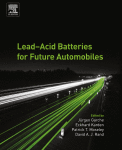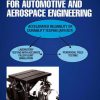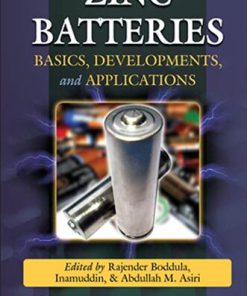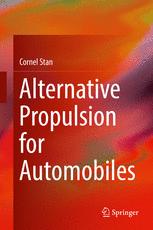Lead Acid Batteries for Future Automobiles 1st edition by Jürgen Garche, Eckhard Karden, Patrick Moseley, David Ran 0444637031 9780444637031
$50.00 Original price was: $50.00.$25.00Current price is: $25.00.
Lead-Acid Batteries for Future Automobiles 1st edition by Jürgen Garche, Eckhard Karden, Patrick T. Moseley, David A. J. Ran – Ebook PDF Instant Download/DeliveryISBN: 0444637031, 9780444637031
Full download Lead-Acid Batteries for Future Automobiles 1st edition after payment.

Product details:
ISBN-10 : 0444637031
ISBN-13 : 9780444637031
Author: Jürgen Garche, Eckhard Karden, Patrick T. Moseley, David A. J. Ran
Lead-Acid Batteries for Future Automobiles provides an overview on the innovations that were recently introduced in automotive lead-acid batteries and other aspects of current research. Innovative concepts are presented, some of which aim to make lead-acid technology a candidate for higher levels of powertrain hybridization, namely 48-volt mild or high-volt full hybrids.
Lead-acid batteries continue to dominate the market as storage devices for automotive starting and power supply systems, but are facing competition from alternative storage technologies and being challenged by new application requirements, particularly related to new electric vehicle functions and powertrain electrification.
Lead-Acid Batteries for Future Automobiles 1st Table of contents:
Part 1. Overview
1. Development trends for future automobiles and their demand on the battery
1.1. Lead–acid batteries in automobiles: still good enough?
1.2. Requirements in the automotive industry
1.3. Vehicle level requirements
1.4. Low-volt system topology options for advanced power supply and mild powertrain hybridization
1.5. Upcoming storage system requirements
1.6. Discussion
List of abbreviations
2. Overview of batteries for future automobiles
2.1. General requirements for batteries in electric vehicles
2.2. Energy storage in lead–acid batteries
2.3. Alkaline batteries
2.4. High-temperature sodium batteries
2.5. Lithium-ion batteries
2.6. Power sources after Lithium-ion
2.7. Supercapacitors
2.8. Fuel cells
3. Lead–acid battery fundamentals
3.1. Principles of operation
3.2. Open-circuit voltage
3.3. Voltage during discharge and charge
3.4. Designs and manufacture
3.5. Charging
3.6. Heat management in lead–acid batteries
3.7. Failure modes and remedies
3.8. Capacity
3.9. Self-discharge
3.10. Dynamic charge-acceptance
3.11. Summing up
Abbreviations, acronyms and initialisms
4. Current research topics for lead–acid batteries
4.1. Design and materials
4.2. Operating strategy
4.3. Battery monitoring
4.4. Dual battery systems
4.5. Discussion
Part 2. Battery Technology
5. Flooded starting-lighting-ignition (SLI) and enhanced flooded batteries (EFBs): State-of-the-art
5.1. History of lead–acid batteries in combustion engine cars
5.2. Board net architecture and car requirements on batteries
5.3. Flooded automotive battery design and production technologies: status and latest improvements
5.4. Market trends
Abbreviations, acronyms and initialisms
6. Automotive absorptive glass-mat lead–acid batteries: State of the art
6.1. Lead–acid batteries in vehicle electrical systems
6.2. Global standardization of automotive AGM batteries
6.3. Vehicle systems: voltages and battery technologies
6.4. Launch of automotive AGM batteries
6.5. Start–stop: factor of success for AGM batteries
6.6. Advantages of AGM over flooded automotive batteries
6.7. Cycling endurance of AGM batteries
6.8. Capability for dynamic charge-acceptance
6.9. Packaging in vehicles: heat-resilience of AGM batteries
6.10. Future applications for AGM batteries
6.11. Replacement of spent AGM batteries
6.12. Summary: automotive AGM batteries
Abbreviations, acronyms and initialisms
7. Performance-enhancing materials for lead–acid battery negative plates
7.1. Introduction
7.2. Expanders
7.3. Structural influences
7.4. Challenge of high-rate partial state-of-charge duty
7.5. Addition of carbon
7.6. Types of battery configuration
7.7. Understanding the carbon effect
7.8. Best choice of carbon
Abbreviations, acronyms and initialisms
8. Positive active-materials for lead–acid battery plates
8.1. Introduction
8.2. Operating principles
8.3. Positive plate construction
8.4. Manufacturing process
8.5. Failure modes and remedies
8.6. Future developments
Abbreviations, acronyms and initialisms
9. Current-collectors for lead–acid batteries
9.1. Introduction
9.2. Reactions at the surface of the positive grid
9.3. Antimony-free grids
9.4. Lead–calcium alloys
9.5. Tin additions to pure lead
9.6. Tin additions to lead–calcium alloys
9.7. Bookmould-cast lead–calcium–tin grids
9.8. Rolled lead–calcium–tin grids
9.9. Corrosion of lead–calcium–tin alloy grids
9.10. Grids for elevated temperatures
9.11. Spiral-wound grids
9.12. Novel grids designs
9.13. Composite grids
9.14. Thin grids
9.15. Straps and posts
Abbreviations, acronyms and initialisms
10. Alternative current-collectors
10.1. Introduction
10.2. Function, design and characteristic parameters of lead–acid battery current-collectors
10.3. Metallized injection moulded plastic grids
10.4. Copper and aluminium grids
10.5. Titanium current-collectors
10.6. Alternative current-collectors based on fibrous materials
10.7. Foam grids
10.8. Carbon honeycomb grids
10.9. Conclusion
Abbreviations, acronyms and initialisms
11. Cell design for high-rate operation
11.1. The reason why we need high-rate operation and why it is so critical and challenging
11.2. Fundamental theoretical considerations about high-rate operation
11.3. Key parameters for high-rate plate design
11.4. Alternative plate and cell designs for high-rate operation
11.5. Additional plate and cell design parameters and their impact
11.6. Outlook for the lead–acid design for further advanced high-rate applications
List of abbreviations
12. Towards sustainable road transport with the UltraBattery™
12.1. Most promising and affordable designs of hybrid electric vehicle
12.2. Failure mechanism of lead–acid batteries under high-rate partial state-of-charge duty
12.3. Improving the cycleability of lead–acid batteries under high-rate partial state-of-charge duty
12.4. The UltraBattery™
12.5. The UltraBattery™ tomorrow: challenges and prospects
12.6. Concluding remarks
Abbreviations, acronyms and initialisms
Part 3. Application Technology
13. Lead–acid battery operation in micro-hybrid and electrified vehicles
13.1. Introduction
13.2. Storage system requirements and operating strategies
13.3. Charging strategies
13.4. Lead–acid batteries in electric and hybrid vehicles
14. Monitoring techniques for 12-V lead–acid batteries in automobiles
14.1. Historic overview towards battery sensors
14.2. Requirements of battery sensors
14.3. Lead–acid battery monitoring functions
14.4. Algorithms for battery state detection of lead–acid batteries
14.5. Validation of battery state detection output signals
14.6. Field experience
14.7. Outlook on future development
15. Dual battery systems for 12-V automotive power supply
15.1. Outline
15.2. Drivers for dual storage
15.3. Requirements for a dual storage power-supply system
15.4. Potential topologies
15.5. Integration of the auxiliary battery into the vehicle and its electrical system
15.6. Market trends
16. Basics of lead–acid battery modelling and simulation
16.1. Introduction
16.2. Levels of battery modelling
16.3. Specific challenges for modelling lead–acid batteries
16.4. Models for electrical performance
16.5. Models for battery ageing
Abbreviations, acronyms and initialisms
17. Batteries for heavy trucks
17.1. Introduction
17.2. Dimensions
17.3. Key requirements
17.4. Electrical network voltage for heavy trucks
17.5. Truck battery design considerations
17.6. Advanced truck battery technologies
17.7. Advanced system integration of truck batteries
17.8. Summary
Abbreviations, acronyms and initialisms
18. Lead–acid batteries for E-bicycles and E-scooters
18.1. Introduction
18.2. Description of electric two wheelers
18.3. Market
18.4. Characteristics of electric two wheelers
18.5. Battery
18.6. Summary
Abbreviations, acronyms and initialisms
Part 4. Product Life Cycle
19. Standards and tests for lead–acid batteries in automotive applications
19.1. Standardization organizations and different levels of standardization
19.2. Obligations of standards and different kind of standards
19.3. Standardization in different regions and list of applicable standards for lead–acid batteries in automotive applications
19.4. Procedure to publish a new standard
19.5. Battery sizes in comparison and trends
19.6. Comparison of typical lead–acid battery requirements and test procedures
19.7. External standards in comparison to original equipment specifications
20. Recycling concepts for lead–acid batteries
20.1. Introduction
20.2. The process
20.3. Removal of sulfur
20.4. Battery breaking
20.5. Lead smelting
20.6. Lead refining
20.7. Electrochemical practice
20.8. Recent developments
20.9. Conclusion
Abbreviations, acronyms and initialisms
Part 5. Outlook
21. Lead–acid batteries for future automobiles: Status and prospects
21.1. Tomorrow’s automobile batteries: drivers for change
21.2. Electrified vehicles and the demands placed on their batteries
21.3. Restrictions on the use of lead
21.4. Can lead–acid battery technology keep pace with increasing electrification of vehicles?
21.5. Closing remarks
People also search for Lead-Acid Batteries for Future Automobiles 1st:
lead acid battery companies
lead acid car battery lifespan
lead acid battery applications
how do lead acid car batteries work
lead acid battery for car audio
Tags: Lead Acid Batteries, Future Automobiles, Jürgen Garche, Eckhard Karden, Patrick Moseley, David Ran
You may also like…
Engineering - Energy & Power Resources
Biology and other natural sciences
Engineering - Automotive
Alternative Propulsion for Automobiles 1st Edition Cornel Stan
Business & Economics - Management & Leadership
Future Studies and Counterfactual Analysis: Seeds of the Future Theodore J. Gordon
Engineering
Cognitive Systems Engineering: The Future for a Changing World 1st Edition Philip J. Smith












